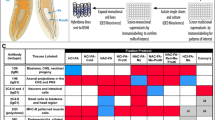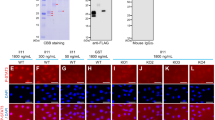Abstract
The Agr (anterior gradient) group proteins belong to the family of proteins with a noncanonical thioredoxin motif and are involved in the regulation of various processes: embryonic development, regeneration, and oncogenesis. Normally, the human Agr2 gene is predominantly expressed in the secreting cells of mucin-producing organs. However, Agr2 is associated with active metastasis during the development of some types of malignant tumors. The molecular mechanism of its functioning is poorly understood. The model of Xenopus laevis embryos is one of the most convenient and available basic models for the proper study of various molecular mechanisms and signaling cascades of proteins. Previously, only the expression activity of the Agr genes was studied in this model; in particular, active expression of the Agr2 gene was demonstrated in the early stages of embryonic development and during tadpole regeneration of the tail and hindlimbs in Xenopus laevis. To begin the study on the molecular mechanism of the Agr2 protein functioning, it is necessary to obtain Agr2 specific antibodies and to test their effectiveness, which was the main goal of this work. The obtained purified antibodies were tested by the immunohistochemical method; as a result, the distribution pattern of the Agr2 protein during early development of the embryos and in regenerating tails of the tadpoles of Xenopus laevis, completely coinciding with the expression pattern of this gene, was first obtained.

Similar content being viewed by others
REFERENCES
Aberger, F., Weidinger, G., Grunz, H., and Richter, K., Anterior specification of embryonic ectoderm: the role of the Xenopus cement gland-specific gene XAG-2, Mech. Dev., 1998, vol. 72, nos. 1–2, pp. 115–130. http://doi.org/10.1016/S0925-4773(98)00021-5.
Carlson, B., Chapter 1–An Introduction to Regeneration, in Principles of Regenerative Biology, 2007, pp. 1–29. http://doi.org/10.1016/B978-012369439-3/50003-9.
Gray, T.A., MacLaine, N.J., Michie, C.O., Bouchalova, P., Murray, E., Howie, J., Hrstka, R., Maslon, M.M., Nenutil, R., Vojtesek, B., Langdon, S., Hayward, L., Gourley, C., and Hupp, T.R., Anterior gradient-3: a novel biomarker for ovarian cancer that mediates cisplatin resistance in xenograft models, J. Immunol. Methods, 2012, vol. 378, nos. 1–2, pp. 20–32. http://doi.org/10.1016/j.jim.2012.01.013.
Ivanova, A.S., Tereshina, M.B., Ermakova, G.V., Belousov, V.V., and Zaraisky, A.G., Agr genes, missing in amniotes, are involved in the body appendages regeneration in frog tadpoles, Sci. Rep., 2013, vol. 3, p. 1279. http://doi.org/10.1038/srep01279.
Ivanova, A.S., Shandarin, I.N., Ermakova, G.V., Minin, A.A., Tereshina, M.B., and Zaraisky, A.G., The secreted factor Ag1 missing in higher vertebrates regulates fins regeneration in Danio rerio, Sci. Rep., 2015, vol. 29, no. 5, p. 8123. http://doi.org/10.1038/srep08123.
Kumar, A. and Brockes, J.P., Nerve dependence in tissue, organ, and appendage regeneration, Trends Neurosci., 2012, vol. 35, no. 11, pp. 691–699. http://doi.org/ 10.1016/j.tins.2012.08.003.
Lee, C., Kieserman, E., Gray, R.S., Park, T.J., and Wallingford, J., Whole-mount fluorescence immunocytochemistry on Xenopus embryos, CSH Protoc., 2008, pdb.prot. 4957. http://doi.org/10.1101/pdb.prot4957.
Liu, D., Rudland, P.S., Sibson, D.R., Platt-Higgins, A., and Barraclough, R., Human homologue of cement gland protein, a novel metastasis inducer associated with breast carcinomas, Cancer Res., 2005, vol. 65, no. 9, pp. 3796–3805.
Martynova, N.Y., Eroshkin, F.M., Ermolina, L.V., Ermakova, G.V., Korotaeva, A.L., Smurova, K.M., Gyoeva, F.K., and Zaraisky, A.G., The LIM-domain protein zyxin binds the homeodomain factor Xanf1/Hesx1 and modulates its activity in the anterior neural plate of Xenopus laevis embryo, Dev. Dyn., 2008, vol. 237, no. 3, pp. 736–749. http://doi.org/10.1002/dvdy.21471.
Nieuwkoop, P. and Faber, J., Normal Table of Xenopus laevis (Daudin): A Systematical and Chronological Survey of the Development from the Fertilized Egg till the End of Metamorphosis, New York: Garland Pub., 1994.
Novoselov, V.V., Alexandrova, E.M., Ermakova, G.V., and Zaraisky, A.G., Expression zones of three novel genes abut the developing anterior neural plate of Xenopus embryo, Gene Expr. Patterns, 2003, vol. 3, no. 2, pp. 225–230. http://doi.org/10.1016/S1567-133X(02)00077-7.
Persson, S., Rosenquist, M., Knoblach, B., Khosravi-Far, R., Sommarin, M., and Michalak, M., Diversity of the protein disulfide isomerase family: identification of breast tumor induced Hag2 and Hag3 as novel members of the protein family, Mol. Phylogenet. Evol., 2005, vol. 36, no. 3, pp. 734–740. http://doi.org/10.1016/j.ympev.2005.04.002.
Sive, H.L., Hattori, K., and Weintraub, H., Progressive determination during formation of the anteroposterior axis in Xenopus laevis, Cell, 1989, vol. 58, no. 1, pp. 171–180. http://doi.org/10.1016/0092-8674(89)90413-3.
Tereshina, M.B., Ermakova, G.V., Ivanova, A.S., and Zaraisky, A.G., Ras-dva1 small GTPase regulates telencephalon development in Xenopus laevis embryos by controlling Fgf8 and Agr signaling at the anterior border of the neural plate, Biol. Open, 2014, vol. 3, no. 3, pp. 192–203. http://doi.org/10.1242/bio.20147401.
Author information
Authors and Affiliations
Corresponding authors
Additional information
Translated by D. Novikova
Rights and permissions
About this article
Cite this article
Ivanova, A.S., Martynova, N.Y., Komarov, P.A. et al. Obtaining of Agr2 Specific Antibodies and Determination of the Agr2 Protein Distribution Pattern during Early Embryonic Development and Tadpole Regeneration in Xenopus laevis. Russ J Dev Biol 49, 393–397 (2018). https://doi.org/10.1134/S1062360418060036
Received:
Published:
Issue Date:
DOI: https://doi.org/10.1134/S1062360418060036




